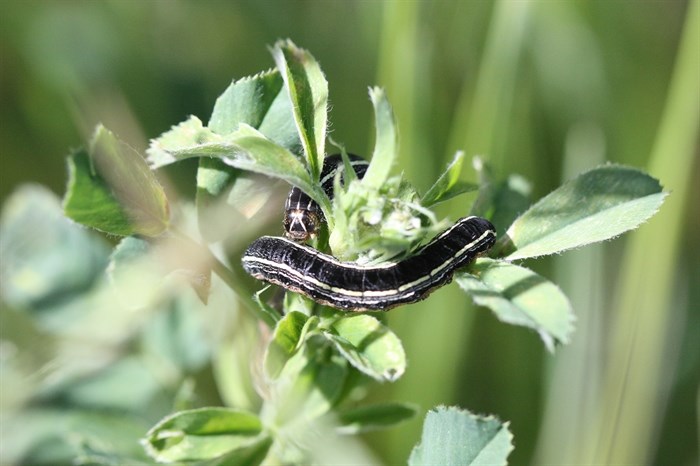
First spotted in 2018 the bugs have appeared again in the North Okanagan.
Image Credit: SUBMITTED/B.C. Ministry of Agriculture
June 05, 2019 - 6:00 AM
NORTH OKANAGAN - An army of caterpillars first spotted in the North Okanagan last year, have returned again in full force and pose a serious concern for many of the region's farmers.
The western yellowstriped armyworm appeared in Armstrong, Enderby and the Spallumcheen area for the first time last July alarming farmers, gardeners and the Ministry of Agriculture.
Ministry of Agriculture entomologist Susanna Acheampong said earlier this year traps were set up on farms to monitor the caterpillars, which have shown up in "really high numbers" again this summer.
"It's really a serious problem," Acheampong said. "The way they move it's very very difficult to control."
Acheampong said the caterpillars will feed on alfalfa, corn and a variety of other crops, causing concern for farmers. Acheampong said the armyworms will also feed on regular household plants and decimate residential gardens.
Armstrong Asparagus Farm owner Mark Jeppesen said the farm first experienced the armyworms last year but so far this year hasn't been affected. But less than one kilometre away is awash with the pests.
"The roads (are) turning black from the tires running over them," Jeppesen said.
Once his crop of asparagus is due to be picked by June 20, Jeppesen believes the caterpillars may make their way to the stalks after harvesting. If they do, the only option will be to spray the crops, something he doesn't normally do to control insects.
Farmers across the region reported that they had not seen the caterpillars before they appeared in the summer of 2018, and Acheampong said research is currently underway to study where the armyworms have come from. Depending on where the caterpillars originated from will depend on what plan of action is taken going forward. If they are native to the area, scientists can work out why they hadn't been seen before, and if they are from elsewhere there's a chance they may not return next year.
Acheampong said scientists aren't sure whether the bugs survived the winter or arrived from elsewhere this year.
Acheampong said the ministry does have guidelines for farmers and gardeners to mitigate the impact of the caterpillars but scientists need to learn more about the armyworms before a longterm plan can be devised.
For the time being, the ministry is asking farmers and homeowners to report caterpillars and damage seen in new regions to the Ministry of Agriculture.
Information about the western yellowstriped armyworm, including tips on how to mitigate their effect and contact information for new sightings, can be found here.
To contact a reporter for this story, email Ben Bulmer or call (250) 309-5230 or email the editor. You can also submit photos, videos or news tips to the newsroom and be entered to win a monthly prize draw.
We welcome your comments and opinions on our stories but play nice. We won't censor or delete comments unless they contain off-topic statements or links, unnecessary vulgarity, false facts, spam or obviously fake profiles. If you have any concerns about what you see in comments, email the editor in the link above.
News from © iNFOnews, 2019